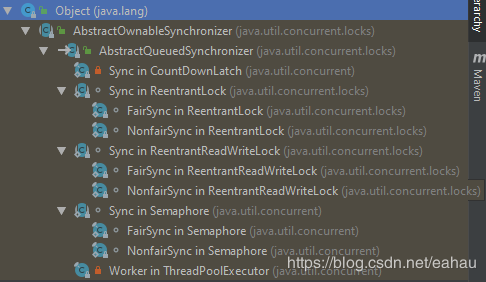耐心看完的你或多或少会有收获!
Java并发的核心就是 java.util.concurrent 包,而 j.u.c 的核心是AbstractQueuedSynchronizer抽象队列同步器,简称 AQS,一些锁啊!信号量啊!循环屏障啊!都是基于AQS。而 AQS 又是基于Unsafe的一系列compareAndSwap,所以理解了这块,并发不再是问题!
希望你已经了解了 Java内存模型
何为 CAS
先解释下何为compareAndSwap,就拿AtomicInteger来举例了:
// 实际操作的值
private volatile int value;
// value 的偏移量 因为 int 是32位,知道首部地址就可以了
private static final long valueOffset;
// 静态初始化块,通过虚拟机提供的接口,获得 valueOffset = 12
// 不论你实例化多少个 AtomicInteger 对象,这些对象尽管指向不同的堆内存,但是结构都是一样的
// 所以初始化一次就好了
static {
try {
valueOffset = unsafe.objectFieldOffset
(AtomicInteger.class.getDeclaredField("value"));
} catch (Exception ex) { throw new Error(ex); }
}
// 只是个封装方法,起作用的代码并不在这
// 值得注意的是显式的 this 和第三个参数 1
public final int getAndIncrement() {
return unsafe.getAndAddInt(this, valueOffset, 1);
}
// 以下是 Unsafe 类 可以直接访问内存地址,类似指针,所以不安全
// o 就是 getAndIncrement()传入的 this,也就是 AtomicInteger 实例对象
// offset 内存首部偏移量
// delta 就是那个 1
// 应该是希腊字母 δ /'deltə/ delta 变化量,化学反应中的加热,屈光度,一元二次方程中的判别式
// 佩服
public final int getAndAddInt(Object o, long offset, int delta) {
int v;
do {
v = getIntVolatile(o, offset);
} while (!compareAndSwapInt(o, offset, v, v + delta));
return v;
}
// 从堆内存获取最新的 value
// 如果不明白,可以先了解下 JMM 和 volatile
public native int getIntVolatile(Object o, long offset);
// expected 就是这个 v = getIntVolatile(o, offset);
// 意思就是,我给你这个最新的 value,它要是现在 在内存中还是这个值 那你就返回 true,并且把这块内存上值更新为 x
// 不然的话,我就一直 while (!compareAndSwapInt(o, offset, v, v + delta));
// 相当于自旋锁 活锁,不要被高大上的术语吓到 就是活的循环,不会像死锁那样线程 hang 住
public final native boolean compareAndSwapInt(Object o, long offset, int expected, int x);
何为 Lock
知道了CAS就可以进一步的说说ReentrantLock, 如果不曾了解Java对象结构,建议先了解下 Java 对象的内存结构
AQS的几个子类,由于方法和功能不一,在同步处理的细节上可能不一样。但是,原理都是一样的,离不开上述的CAS

// 我先简单解释一下 synchronized 工作原理 首先它含有 monitorenter 和 monitorexit 两条指令
// Java 中的每个对象都有自己的 Monitor(由HotSpot c++ 实现)
// 当某个线程进入加锁的代码(实际上应该是拿到被加锁的对象在内存的引用地址)
// 会执行 monitorenter 然后将 monitor 置为1,当其它线程访问该内存时,发现 monitor 不为 0
// 所以其它线程无法获得 monitor,直到占有 monitor 的线程执行 monitorexit 退出将 monitor 减 1
// 如果占有 monitor 的线程重复进入,monitor 是可以一直累加的(可重入锁,例如通过递归或方法互调)
// 了解了 synchronized 基本的工作原理,就会明白为什么会有诸如 nonfairTryAcquire(1) release(1) 的方法
// 这是 AbstractQueuedSynchronizer 类中的字段
// 因为 ReentrantLock 中的内部类 Sync 继承于 AQS
// The synchronization state
private volatile int state;
// tryLock why ?
// 因为不同于 synchronized 的悲观(我才不管你是不是并发,多线程,声明了,我就加锁)
// 所以 ReentrantLock 我先 try 一 try 吧!万一不是多线程并发呢!🤣
public boolean tryLock() {
// 加锁 加 1
return sync.nonfairTryAcquire(1);
}
public void unlock() {
// 释放锁 减 1
sync.release(1);
}
final boolean nonfairTryAcquire(int acquires) {
final Thread current = Thread.currentThread();
int c = getState();
// 0 的话 说明没有线程占有
// 可以获得锁
if (c == 0) {
// 这个和上面的 AtomicInteger 一样
if (compareAndSetState(0, acquires)) {
// 设置当前占有锁的线程
setExclusiveOwnerThread(current);
return true;
}
}
else if (current == getExclusiveOwnerThread()) {
int nextc = c + acquires;
// 看见没,锁的计数有可能会有问题
// 因为锁的可重入,一直累加,指不定就加到 int 上限转负数了
if (nextc < 0) // overflow
throw new Error("Maximum lock count exceeded");
// 不小于 0 更新 state
setState(nextc);
return true;
}
return false;
}
// AbstractOwnableSynchronizer 类
// The current owner of exclusive mode synchronization.
// 排它锁 独占锁 写锁 都一个意思 锁的当前持有线程
private transient Thread exclusiveOwnerThread;
ObjectMonitor
Unsafe monitor 的相关方法,已弃用
/** Lock the object. It must get unlocked via {@link #monitorExit}. */
@Deprecated
public native void monitorEnter(Object o);
/**
* Unlock the object. It must have been locked via {@link
* #monitorEnter}.
*/
@Deprecated
public native void monitorExit(Object o);
/**
* Tries to lock the object. Returns true or false to indicate
* whether the lock succeeded. If it did, the object must be
* unlocked via {@link #monitorExit}.
*/
@Deprecated
public native boolean tryMonitorEnter(Object o);
以下为 hotspot c++ 源码的一部分代码,想追根溯源的可以了解下 hotspot 源码(页面左侧提供下载和浏览的链接)
// Enter support
void ObjectMonitor::enter(TRAPS) {
// The following code is ordered to check the most common cases first
// and to reduce RTS->RTO cache line upgrades on SPARC and IA32 processors.
Thread * const Self = THREAD;
void * cur = Atomic::cmpxchg_ptr (Self, &_owner, NULL);
if (cur == NULL) {
// Either ASSERT _recursions == 0 or explicitly set _recursions = 0.
assert(_recursions == 0, "invariant");
assert(_owner == Self, "invariant");
return;
}
if (cur == Self) {
// TODO-FIXME: check for integer overflow! BUGID 6557169. // 看来出现过 count overflow bug
_recursions++; // recursion 递归说明了可重入
return;
}
// 省略
}
void ObjectMonitor::exit(bool not_suspended, TRAPS) {
Thread * const Self = THREAD;
if (THREAD != _owner) {
if (THREAD->is_lock_owned((address) _owner)) {
// Transmute _owner from a BasicLock pointer to a Thread address.
// We don't need to hold _mutex for this transition.
// Non-null to Non-null is safe as long as all readers can
// tolerate either flavor.
assert(_recursions == 0, "invariant");
_owner = THREAD;
_recursions = 0;
} else {
// Apparent unbalanced locking ...
// Naively we'd like to throw IllegalMonitorStateException.
// As a practical matter we can neither allocate nor throw an
// exception as ::exit() can be called from leaf routines.
// see x86_32.ad Fast_Unlock() and the I1 and I2 properties.
// Upon deeper reflection, however, in a properly run JVM the only
// way we should encounter this situation is in the presence of
// unbalanced JNI locking. TODO: CheckJNICalls.
// See also: CR4414101
TEVENT(Exit - Throw IMSX);
assert(false, "Non-balanced monitor enter/exit! Likely JNI locking");
return;
}
}
if (_recursions != 0) {
_recursions--; // this is simple recursive enter
TEVENT(Inflated exit - recursive);
return;
}
// 省略
}
总结一下(感概)
Doug Lea 真正的大师,从他的代码中可以看出对于细节的处理与把控,以及对于我等代码阅读者的友好
大道至简,谁能想到 Java 的并发支持是基于一些加 1 减 1 的运算
synchronized的 Monitor 和各种锁的 tryAcquire(1) tryRelease(1)是不是很像🤣
如果有帮助你理解并发,那么你也可以再结合源码好好感受下,请注意tryAcquire(1) tryRelease(1)这两种方法(方法名或参数可能略有不同)